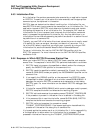DEC Text Processing Utility Program Development
5.3 Writing Code Compatible with DECwindows EVE
• Use the MB1 mouse button with the Shift key to extend a selection
EVE implements a static selection by creating a range upon which you can
perform EVE commands such as STORE TEXT or REMOVE. However, EVE does
not use the DECTPU SELECT built-in procedure to start this range. Thus, if
you use the SELECT_RANGE built-in while a static selection is active, DECTPU
returns the message ‘‘No select active.’’
If you move the text cursor off the text in the static selection, the selection is
canceled.
5.3.1.3 Found Range Selection
When EVE positions to the beginning of a range as the result of the FIND
command, the WILDCARD FIND command, or pressing the Find key, EVE
creates a found range that contains the text EVE found as a match for your
search string. If no other selection is active, EVE treats the found range as the
current selection.
EVE implements a found range selection by creating a range upon which you
can perform EVE commands such as STORE TEXT or REMOVE. However, EVE
does not use the DECTPU SELECT built-in procedure to start this range. Thus,
if you use the SELECT_RANGE built-in while a found range selection is active,
DECTPU returns the message ‘‘No select active.’’
If you move the text cursor off the text in the found range selection, the selection
is canceled.
5.3.1.4 Relation of EVE Selection to DECwindows Global Selection
If EVE has a dynamic selection or a static selection active, that selection is
automatically designated as the primary global selection. A found range selection
is not designated as the primary global selection.
You can use the routine EVE$SELECTION to get the text of the primary global
selection when an application other than DECTPU owns the selection. To do so,
the call to EVE$SELECTION must be in code bound to a mouse button other
than MB1. The value returned is a string that contains the text of the primary
global selection.
5.4 Compiling DECTPU Programs
Before compiling programs in DECTPU, you should enable the display of
informational messages to help you locate errors. EVE automatically enables
the display of informational messages for you when you use the EXTEND EVE
command. For more information on displaying messages, see the description
of the SET (INFORMATIONAL) built-in procedure in the DEC Text Processing
Utility Reference Manual.
The DECTPU compiler numbers the lines of code it compiles. The line numbers
begin with 1. For a string, all DECTPU statements are considered to be on line
1. For a range, line 1 is the first line of the range, regardless of where in the
buffer the range begins. Buffers are numbered starting at the first line. When a
compilation error occurs, DECTPU tells you the approximate line number where
the error occurred. To move to the line at which the error occurred, use the
POSITION (integer) built-in procedure.
In EVE, you can use the LINE command. For example, the command LINE 42
moves the editing point and the cursor to line 42.
5–14 DEC Text Processing Utility Program Development


















